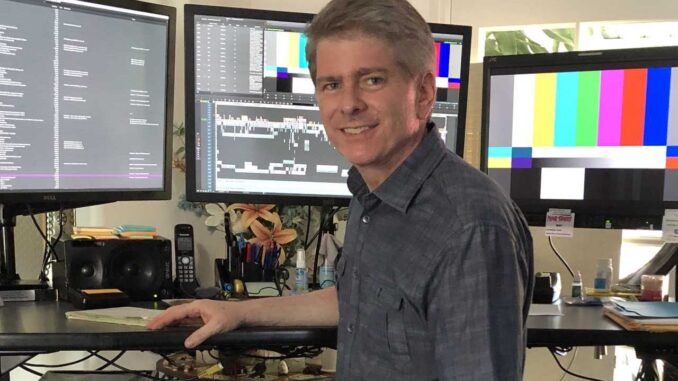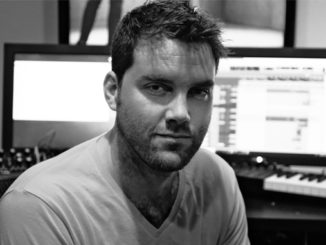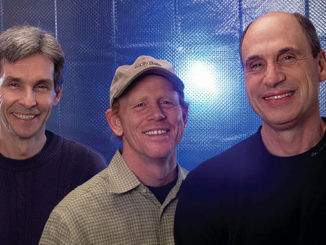
Where are you currently employed?
Freelance.
Current projects?
I’m additional editing on Netflix’s “Fear Street” film trilogy.
Describe your job.
33% craftsman, 33% politician, 33% psychologist, 1% magician.
How did you first become interested in this line of work?
I went to film school thinking—like most film students—that I wanted to be a director. But I soon learned that I didn’t enjoy having to deal with real-world hassles working on a film set. I discovered that my creativity flourished in the dark confines of an editing room. Plus, the editing craft was better suited to my introverted personality.
Who gave you your first break?
In the early 90’s I was lucky enough to get tutored in film editorial (yes, 35mm film) by the talented editor Hibah Schweitzer, ACE. The skills I learned with her helped me get my next job as a second assistant film editor with Benjamin Chulay, ACE, and first assistant Alex Seymour. I learned Avid Media Composer when it became available, and the combination of film and Avid skills helped propel my career as an assistant editor in television and features.
What was your first union job?
In 1994, I was assistant editing on a non-union television movie that “got flipped” to union during production. It was harder to get into the union back then, so I was happy to find my way in.
What credits or projects are you proudest of, and why?
I worked on several feature films where I was able to get my first assistant editor promoted to co-editor with me. A few times I was able to at least get my first assistant promoted to an “additional editor” credit. I enjoy mentoring my assistants in the editing craft, and I am proud when their hard work and creative contribution gets recognized with a bumped-up editing credit.
What was your biggest challenge in your job (or on a particular project) and how did you overcome/solve it?
When editing Don Cheadle’s Miles Davis biopic “Miles Ahead,” I had a very challenging final music sequence. It was a live jazz performance with five prominent musicians. They shot with nine cameras and did six takes. There was a click track, but it was completely useless—because this was live JAZZ! Every take was different, and it was impossible to gang them all together! I definitely had to edit among all six takes, because the five musicians and the nine cameras were always doing different things. I flagged all the best moments, but It was a challenge just to find the jazz beat cutting from one take to another. It took me about four days to finish this sequence with the director. To top it all off, I was sick with whooping cough at the time. But in the end, it remains one of the sequences I am most proud of editing.
What was the most fun you’ve had at work?
I had a blast editing the films “Crazy Heart” and “Rudderless” because I joined each show after production had finished shooting. This meant that I was able to edit both films in chronological story order. It was such a creative relief to put an assembly together this way instead of dealing with the sporadic nature of dailies.
Jobwise, what do you hope to be doing five years from now?
I hope to continue to be editing quality projects with creative people I enjoy working for.
What are your outside activities, hobbies, passions?
I enjoy traveling, photography, and storm chasing!
Favorite movie(s)? Why?
Probably my favorite movie is Alfred Hitchcock’s “Vertigo.” There is something about that film that speaks to male insecurity and vulnerability. It’s rare to see fragile male protagonists resonate as well as Jimmy Stewart in that role. I saw the film when I was much younger, and it profoundly affected me. Plus Alfred Hitchcock was a master filmmaker of the human psyche. “Vertigo” ranks among his best.
Favorite TV program(s)? Why?
Last year I was blown away by HBO’s “Chernobyl.” The portrayal of Soviet 1980s culture was fascinating and captivating, and this real life event was handled expertly in all phases of storytelling. All the crafts — cinematography, editing, production design and direction — were so well done. The character portrayals really humanized this global disaster and themes of government putting their interests over the well-being of its citizens really resonates today.
Do you have an industry mentor?
When I was employed for 10 years as an assistant editor. Pretty much every editor I worked for was a mentor to me. I was very fortunate to have learned the craft (and politics) of editing by having several different editors take me under their wing. If I had to do it all over again, I would not trade in those 10 years of assistant experience. It helped shape me into the editor I am today.
What advice would you offer to someone interested in pursuing your line of work?
I would tell someone interested in pursuing a career in film and television that it’s all about networking. Meet as many people as you can and be especially gracious for their time. Ask for career advice from people already established, and remember to send follow-up “thank you” letters. You will be remembered by people in the industry if you come across as humble, friendly, and hard-working.
Was there ever a circumstance when you had to rely on the Guild for help or assistance?
One of my very first editing jobs was a non-union feature that flipped to union during the shoot—but the producers never told me and continued to pay me non-union until the end. Months after the film had finished, Cathy Repola helped me get my union hours properly credited.
Is there anything you’d like to say to your fellow Guild members, some words of encouragement?
Words of encouragement: get involved! Whether it be running for the Board of Directors serving on a committee, or volunteering at an event, be involved in the great work our Guild is doing. If you don’t have time for any of the above, at least make sure to vote in Guild affairs.
Compiled by Jeffrey Burman.
Interested in being featured in What Our Members Do? Contact Scott Collins at SCollins@editorsguild.com.





